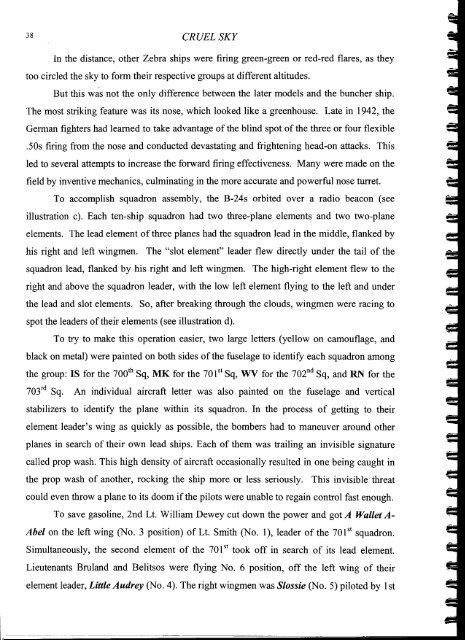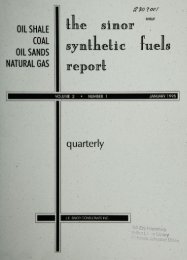Create successful ePaper yourself
Turn your PDF publications into a flip-book with our unique Google optimized e-Paper software.
38 C<strong>RUEL</strong> <strong>SK</strong>Y<br />
In the distance, other Zebra ships were firing green-green or red-red flares, as they<br />
too circled the sky to form their respective groups at different altitudes.<br />
But this was not the only difference between the later models and the buncher ship.<br />
The most striking feature was its nose, which looked like a greenhouse. Late in 1942, the<br />
German fighters had learned to take advantage of the blind spot of the three or four flexible<br />
.50s firing from the nose and conducted devastating and frightening head-on attacks. This<br />
led to several attempts to increase the forward firing effectiveness. Many were made on the<br />
field by inventive mechanics, culminating in the more accurate and powerful nose turret.<br />
To accomplish squadron assembly, the B-24s orbited over a radio beacon (see<br />
illustration c). Each ten-ship squadron had two three-plane elements and two two-plane<br />
elements. The lead element of three planes had the squadron lead in the middle, flanked by<br />
his right and left wingmen. The "slot element" leader tlew directly under the tail of the<br />
squadron lead, flanked by his right and left wingmen. The high-right element flew to the<br />
right and above the squadron leader, with the low left element flying to the left and under<br />
the lead and slot elements. So, after breaking through the clouds, wingmen were racing to<br />
spot the leaders of their elements (see illustration d).<br />
To try to make this operation easier, two large letters (yellow on camouflage, and<br />
black on metal) were painted on both sides of the fuselage to identify each squadron among<br />
the group: IS for the 700th Sq, MK for the 701 st Sq, WV for the 702 nd Sq, and RN for the<br />
703 rd Sq. An individual aircraft letter was also painted on the fuselage and vertical<br />
stabilizers to identify the plane within its squadron. In the process of getting to their<br />
element leader's wing as quickly as possible, the bombers had to maneuver around other<br />
planes in search of their own lead ships. Each of them was trailing an invisible signature<br />
called prop wash. This high density of aircraft occasionally resulted in one being caught in<br />
the prop wash of another, rocking the ship more or less seriously. This invisible threat<br />
could even throw a plane to its doom if the pilots were unable to regain control fast enough.<br />
To save gasoline, 2nd Lt. William Dewey cut down the power and got A Wallet A<br />
Abel on the left wing (No.3 position) of Lt. Smith (No.1), leader of the 701 st squadron.<br />
Simultaneously, the second element of the 701 st took off in search of its lead element.<br />
Lieutenants Bruland and Belitsos were flying No. 6 position, off the left wing of their<br />
element leader, Little Audrey (No.4). The right wingmen was Slossie (No.5) piloted by 1st















![pace SrntfletIc fne]its report - Alliance Digital Repository](https://img.yumpu.com/10493335/1/190x245/pace-srntfletic-fneits-report-alliance-digital-repository.jpg?quality=85)
